Mighty Mites
It's been a tough year for bluebirds in Ohio. First, there was the mid-April cold spell--a ten day marathon in which many early nests were lost. It's tough to incubate eggs and feed babies, when it gets down to 20 degrees at night and barely gets above the 40's during the day. The weather settled down for awhile, and then we had the driest May and June since 1988. That hurts insect populations. Clutch sizes fell accordingly--three-egg second clutches were the norm. But mites, which are more closely related to spiders and ticks, flourish in dry weather. Man, do they flourish. This is the first year I've lost bluebirds to mite infestations, and I've been monitoring at least 20 nest boxes each year since 1982. That's a whole lot of nests peeked into, a whole lot of notes taken. Never have I seen mites like I'm seeing in 2007. Five of my boxes were heavily infested, and I've lost three young in two boxes to mites. It drives me nuts when I'm traveling a lot and can't be there to change nests. But I got to the one in the far orchard just in the nick of time. The day after we came back from Maine, I was out in the morning, checking boxes. They hadn't been checked in two weeks--an unavoidable, but unacceptably long interval. Sure enough, this nest, which had only a couple of eggs when I left, was overrun with mites. One baby had just died, and a second was dying. The third looked all right, but both remaining young had mites seething over their tender skin, and worse, stuffed into their ears. Bleccch!
I closed the box and ran back to the house, picking mites off my arms and out of my eyebrows the whole way. Eek!
I grabbed my bag of dry grass, a toothbrush, a Tupperware container, and a thermal mug full of boiling water. Reaching the box, I took the babies out of their infested nest and put them in a paper towel lined Tupperware. For some reason, when you put mite-infested babies on white paper towels, the mites swarm off them and onto the towels.
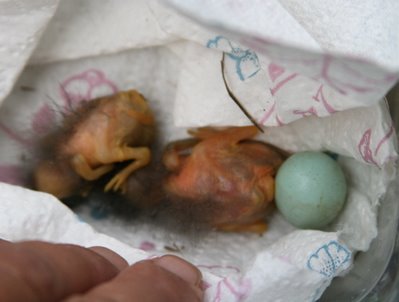 I don't know why, but I'm glad they do. I removed the seething nest, carried it a good distance away and pitched it into the woods. Next, I scrubbed the box with the toothbrush, loosening the mites packed into its seams. Then, I dashed boiling water into the box, three times for good measure. Dead mites ran out with the water. Why use poisonous insecticide when hot water is so much safer and faster?
I don't know why, but I'm glad they do. I removed the seething nest, carried it a good distance away and pitched it into the woods. Next, I scrubbed the box with the toothbrush, loosening the mites packed into its seams. Then, I dashed boiling water into the box, three times for good measure. Dead mites ran out with the water. Why use poisonous insecticide when hot water is so much safer and faster?When the box had cooled, I made a new nest and stuffed it in.
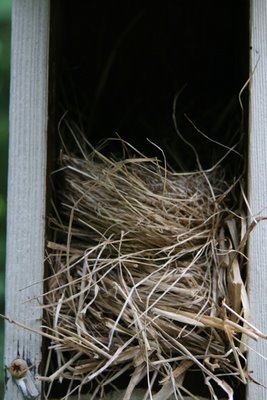
While the box cooled, I used fine blades of grass to flick mites out of the nestling's ear openings. Poor little things. The weaker baby was badly dehydrated, not even able to right itself, and a sickly yellow in color. Any more, I can tell immediately when a box has mites, even before they swarm up my arms, by the anaemic yellow skin of the nestlings.
I gave this baby a 50/50 chance of survival, improved by the fact that the parents had only two to tend, and vastly improved by their now mite-free box. I closed the box and came back two days later, to find the once-dying baby all pink and plump, cuddling with its sibling in their crude hand-made nest, comfortable, hydrated, in possession of all its red blood cells, and well-fed for the first time. The chance to make a difference, even in one bird's life, is part of what keeps me going.
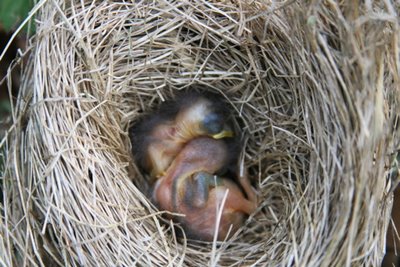 That, and the things I see as I make the rounds...butterflyweed in full glory.
That, and the things I see as I make the rounds...butterflyweed in full glory. 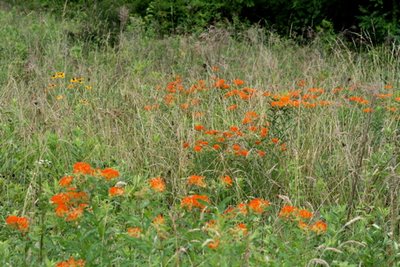
A bumblebee, navigating fields of nectar.
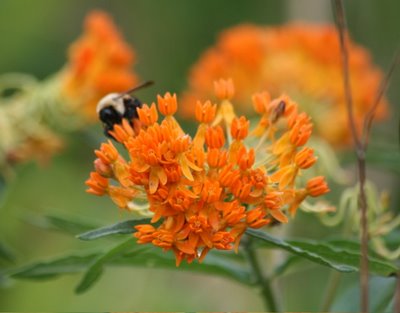
And an indigo bunting nest, eggs an unexpected white (why in the Sam hill would an open-cup nester have WHITE eggs?
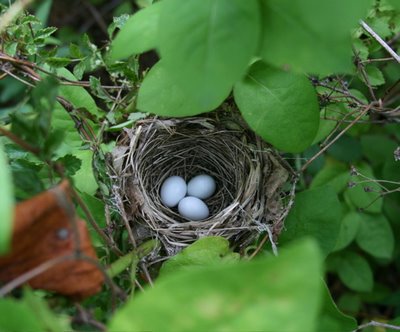 They stick out like a sore thumb! Somebody explain this to the Science Chimp, pleeeeeze. I'm staying away from this nest, though the thing I'd most like to do is stick my camera in it every day. What would be the point of photographing it if I just wound up leading a 'coon to it? Ahhh, it's torture, but I have to do what's best for the birds. The little hen bathes in my bird spa every afternoon at about the same time, and her handsome mate uses the backyard bird bath. They're my neighbors. I have to keep my big nose out of their bidness.
They stick out like a sore thumb! Somebody explain this to the Science Chimp, pleeeeeze. I'm staying away from this nest, though the thing I'd most like to do is stick my camera in it every day. What would be the point of photographing it if I just wound up leading a 'coon to it? Ahhh, it's torture, but I have to do what's best for the birds. The little hen bathes in my bird spa every afternoon at about the same time, and her handsome mate uses the backyard bird bath. They're my neighbors. I have to keep my big nose out of their bidness.Labels: butterfly weed, indigo bunting nest, mite infested bluebird nest, Mites, saving baby bluebirds






<< Home